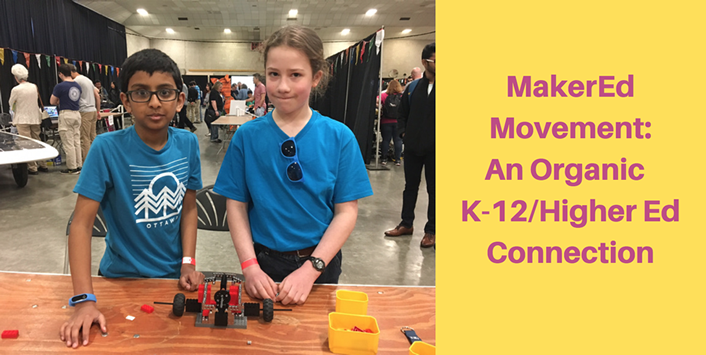
Shortly before the turn of the Millennium, the work world shifted toward a digital environment, and academia followed shortly thereafter. While some high schools retained shop classes and home economics, much of the ‘making’ aspect of K-12 education existed either in art classes or in class projects of earlier grades. Experimentation and creation happened virtually.
I was a part of that shift. Homework was submitted online and research was conducted largely without the use of a card catalogue. It was exciting, being on the cusp of such large systemic changes. It was also incredibly lucky timing, in terms of riding the crest of a giant tech wave that won’t subside anytime soon.
Yet progress isn’t necessarily linear. While some technologies like virtual reality and augmented reality suggest that this shift continues ever forward, in reality, this isn’t the case. There is a parallel trend across higher ed and K-12 — one that’s given rise to a new generation of inventors, creators and tinkerers.
The maker movement has arrived within all levels of education.
Initially hailed as a bridge between higher ed and industry, makerspaces have enabled college students to design, prototype, create and iterate using computers, power tools, 3D printers, arts and crafts, and electronics. They’ve reintroduced a playful element to learning within a ‘sage on the stage’ environment. But the movement is reaching and influencing students far younger than those enrolled in university degree programs.
On an unseasonably warm Sunday this past April — Easter Sunday, in fact — over a thousand area school children and teens gathered in Cambridge for a special one-day event. (It was not an egg hunt.)
They were waiting in line to get into MIT’s Zesiger Sports and Fitness Center to experience the university’s MakerFest. Developed by a group of undergraduate and graduate students, MITxMake invited companies and organizations from across the region and the globe to ‘inspire attendees to think creatively about building products, finding inventive solutions to everyday problems, and get hands-on experience building something new’. Attendees gathered to eagerly assemble and rebuild creations with BRIXO’s new electricity-conducting building blocks; they squealed while constructing and programming basic robots with Makeblock, and enjoyed getting crafty with Chibitronics’ LED Circuit Stickers. They quickly manipulated the smart toys with MacGuyver-esque ingenuity, creating ‘outside the lines’ just as the visiting organizations had intended.
Despite the cache, this gathering in Cambridge wasn’t unique. A global network of makerfaires, makerfests, and similar events have sprung up at universities, secondary and primary schools across the globe, providing a combination of hands-on creation and technology use that is a hallmark of maker ed.
Yet what is most remarkable, perhaps, may be how students are encouraging other students as makers both inside and outside the classroom. DIY characterizes a sort of disciplinary depth and breadth likely unattainable by rote instruction alone.
Media outlets have taken notice of the trend. EdSurge has published a guide for schools to kick off their first maker programs.
Such programs are appealing to schools, higher ed institutions, and students of all ages for a variety of reasons — decreasing screen time not the least of them. Here are just a few of them:
- Maker programs give tangible, new meaning to cause and effect. https://twitter.com/BloomfieldTech/status/860478405090869248
- Hands-on learning in tech and engineering encourages women and minorities to enter STEM fields. https://twitter.com/stef_nguyen/status/860622585226285057
- Creative projects bring history and the contributions of others — including those of underrepresented groups — to life. https://twitter.com/aVndrwrff/status/857822959666307072
- Makerspaces appeal to all kinds of learners: kinesthetic, auditory, and visual, among others. https://twitter.com/MarkLoundy/status/857801930726268929
Want to learn more about the maker movement? Check out these helpful resources:
- The 2016 Horizon Report: Higher Education Edition (see p..42)
- ELI 7 Things You Should Know About Makerspaces
- NGLC blog post: Students Design, Tinker, Create and Discover through Maker-based Learning
- NGLC blog post: How do we make maker educators?
Kristi DePaul of Founders Marketing provides editorial support and regular contributions to the Transforming Higher Ed column of EDUCAUSE Review on issues of teaching, learning, and edtech.
